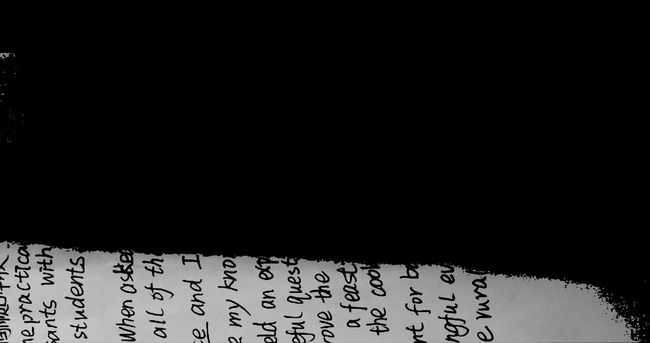图像二值化
目录
1.固定值二值化
2.自适应阈值二值化
3.Android JNI完整代码
1.固定值二值化
固定阈值二值化是OpenCV中一种简单而常用的图像处理技术,用于将图像转换为二值图像。在固定阈值二值化中,像素值根据一个预定义的阈值进行分类,大于阈值的像素被设置为白色,而小于或等于阈值的像素被设置为黑色。以下是关于OpenCV固定阈值二值化的一些重要知识点:
1.阈值函数:在OpenCV中,固定阈值二值化可以使用 threshold() 函数来实现。该函数的原型如下:
double threshold(InputArray src, OutputArray dst, double thresh, double maxValue, int thresholdType);
src:输入图像,通常为灰度图像。dst:输出二值图像,与输入图像具有相同的大小和类型。thresh:固定阈值,用于将像素分类为黑色或白色。maxValue:分配给大于阈值的像素的像素值。thresholdType:阈值类型,用于指定阈值化的方式,如THRESH_BINARY、THRESH_BINARY_INV等。
2.阈值类型:使用 thresholdType 参数可以选择不同的固定阈值化类型,以满足特定需求。一些常用的阈值类型包括:
THRESH_BINARY:二进制阈值化,大于阈值的像素值设为maxValue,小于等于阈值的像素值设为 0。THRESH_BINARY_INV:反二进制阈值化,大于阈值的像素值设为 0,小于等于阈值的像素值设为maxValue。THRESH_TRUNC:截断阈值化,大于阈值的像素值设为阈值,小于等于阈值的保持不变。THRESH_TOZERO:截断到零阈值化,大于阈值的像素值保持不变,小于等于阈值的像素值设为 0。THRESH_TOZERO_INV:反截断到零阈值化,大于阈值的像素值设为 0,小于等于阈值的像素值保持不变。
3.例子
(原图)
1.将彩色图像image转换为灰度图像
Mat gray;
cvtColor(image,gray,COLOR_BGR2GRAY);(灰度图像)
2.彩色图像二值化
Mat img_B,img_B_V;
threshold(image,img_B,125,255,THRESH_BINARY);
imwrite("/sdcard/DCIM/img_B.png",img_B);
3.灰度图BINARY二值化
Mat gray_B,gray_B_V;
threshold(gray,gray_B,125,255,THRESH_BINARY);
threshold(gray,gray_B_V,125,255,THRESH_BINARY_INV);
imwrite("/sdcard/DCIM/gray_B.png",gray_B);
imwrite("/sdcard/DCIM/gray_B_V.png",gray_B_V);gray_B gray_B_V
4.灰度图像TOZERO变换
Mat gray_T,gray_T_V;
threshold(gray,gray_T,125,255,THRESH_TOZERO);
threshold(gray,gray_T_V,125,255,THRESH_TOZERO_INV);
imwrite("/sdcard/DCIM/gray_T.png",gray_T);
imwrite("/sdcard/DCIM/gray_T_V.png",gray_T_V);gray_T gray_T_V
5.灰度图像TRUNC变换
Mat gray_TRUNC;
threshold(gray,gray_TRUNC,125,255,THRESH_TRUNC);
imwrite("/sdcard/DCIM/gray_TRUNC.png",gray_TRUNC); gray_TRUNC
6.灰度图像大津法和三角形法二值化
Mat img_Thr;
cvtColor(image,img_Thr,COLOR_BGR2GRAY);
Mat img_Thr_0,img_Thr_T;
threshold(img_Thr,img_Thr_0,100,255,THRESH_BINARY|cv::THRESH_OTSU);
threshold(img_Thr,img_Thr_T,125,255,THRESH_BINARY|cv::THRESH_TRIANGLE);
imwrite("/sdcard/DCIM/img_Thr_0.png",img_Thr_0);
imwrite("/sdcard/DCIM/img_Thr_T.png",img_Thr_T);img_Thr_T img_Thr_0
2.自适应阈值二值化
1.自适应阈值函数:OpenCV中的自适应阈值二值化可以使用 adaptiveThreshold() 函数来实现。该函数的原型如下:
void adaptiveThreshold(InputArray src, OutputArray dst, double maxValue, int adaptiveMethod, int thresholdType, int blockSize, double C);
- src:输入图像,通常为灰度图像。
- dst:输出二值图像,与输入图像具有相同的大小和类型。
- maxValue:分配给超过阈值的像素的像素值。
- adaptiveMethod:自适应阈值化方法,用于指定计算局部阈值的方式,可以是 ADAPTIVE_THRESH_MEAN_C 或 ADAPTIVE_THRESH_GAUSSIAN_C。
- thresholdType:阈值化类型,用于指定阈值化的方式,如 THRESH_BINARY、THRESH_BINARY_INV 等。
- blockSize:用于计算局部阈值的像素领域大小。必须是奇数且大于1。
- C:从计算阈值中减去的常数。通常为正值。
2.自适应阈值化方法:使用 adaptiveMethod 参数可以选择不同的自适应阈值化方法,以满足特定需求。在OpenCV中,常见的自适应阈值化方法有两种:
-
ADAPTIVE_THRESH_MEAN_C:根据领域中像素的均值计算局部阈值。
-
ADAPTIVE_THRESH_GAUSSIAN_C:根据领域中像素的加权和(权重为高斯窗口)计算局部阈值。
3.灰度图像转换:在进行自适应阈值二值化之前,要将彩色图像转换为灰度图像。可以使用 cvtColor() 函数将彩色图像转换为灰度图像。
cvtColor(image,img_Thr,COLOR_BGR2GRAY);4.例子
Mat adaptive_mean,adaptive_gauss;
adaptiveThreshold(img_Thr,adaptive_mean,255,ADAPTIVE_THRESH_MEAN_C,THRESH_BINARY,55,0);
adaptiveThreshold(img_Thr,adaptive_gauss,255,ADAPTIVE_THRESH_GAUSSIAN_C,THRESH_BINARY,55,0);
imwrite("/sdcard/DCIM/adaptive_mean.png",adaptive_mean);
imwrite("/sdcard/DCIM/adaptive_gauss.png",adaptive_gauss);adaptive_gauss adaptive_mean
3.Android JNI完整代码
#include
#include
#include
#include
#include
#include
#define LOG_TAG "xxx"
#define LOGD(...) __android_log_print(ANDROID_LOG_DEBUG, LOG_TAG, __VA_ARGS__)
using namespace cv;
using namespace std;
extern "C"
JNIEXPORT void JNICALL
Java_com_example_myapplication_MainActivity_opencv_1test(JNIEnv *env, jclass clazz,
jobject bitmap) {
AndroidBitmapInfo info;
void *pixels;
CV_Assert(AndroidBitmap_getInfo(env, bitmap, &info) >= 0);
//判断图片是位图格式有RGB_565 、RGBA_8888
CV_Assert(info.format == ANDROID_BITMAP_FORMAT_RGBA_8888 ||
info.format == ANDROID_BITMAP_FORMAT_RGB_565);
CV_Assert(AndroidBitmap_lockPixels(env, bitmap, &pixels) >= 0);
CV_Assert(pixels);
//将bitmap转化为Mat类
Mat image(info.height, info.width, CV_8UC4, pixels);
Mat gray;
cvtColor(image,gray,COLOR_BGR2GRAY);
imwrite("/sdcard/DCIM/gray23.png",gray);
Mat img_B,img_B_V,gray_B,gray_B_V,gray_T,gray_T_V,gray_TRUNC;
//彩色图像二值化
threshold(image,img_B,125,255,THRESH_BINARY);
imwrite("/sdcard/DCIM/img_B.png",img_B);
//灰度图BINARY二值化
threshold(gray,gray_B,125,255,THRESH_BINARY);
threshold(gray,gray_B_V,125,255,THRESH_BINARY_INV);
imwrite("/sdcard/DCIM/gray_B.png",gray_B);
imwrite("/sdcard/DCIM/gray_B_V.png",gray_B_V);
//灰度图像TOZERO变换
threshold(gray,gray_T,125,255,THRESH_TOZERO);
threshold(gray,gray_T_V,125,255,THRESH_TOZERO_INV);
imwrite("/sdcard/DCIM/gray_T.png",gray_T);
imwrite("/sdcard/DCIM/gray_T_V.png",gray_T_V);
//灰度图像TRUNC变换
threshold(gray,gray_TRUNC,125,255,THRESH_TRUNC);
imwrite("/sdcard/DCIM/gray_TRUNC.png",gray_TRUNC);
//灰度图像大津法和三角形法二值化
Mat img_Thr;
cvtColor(image,img_Thr,COLOR_BGR2GRAY);
Mat img_Thr_0,img_Thr_T;
threshold(img_Thr,img_Thr_0,100,255,THRESH_BINARY|cv::THRESH_OTSU);
threshold(img_Thr,img_Thr_T,125,255,THRESH_BINARY|cv::THRESH_TRIANGLE);
imwrite("/sdcard/DCIM/img_Thr_0.png",img_Thr_0);
imwrite("/sdcard/DCIM/img_Thr_T.png",img_Thr_T);
Mat adaptive_mean,adaptive_gauss;
adaptiveThreshold(img_Thr,adaptive_mean,255,ADAPTIVE_THRESH_MEAN_C,THRESH_BINARY,55,0);
adaptiveThreshold(img_Thr,adaptive_gauss,255,ADAPTIVE_THRESH_GAUSSIAN_C,THRESH_BINARY,55,0);
imwrite("/sdcard/DCIM/adaptive_mean.png",adaptive_mean);
imwrite("/sdcard/DCIM/adaptive_gauss.png",adaptive_gauss);
}











